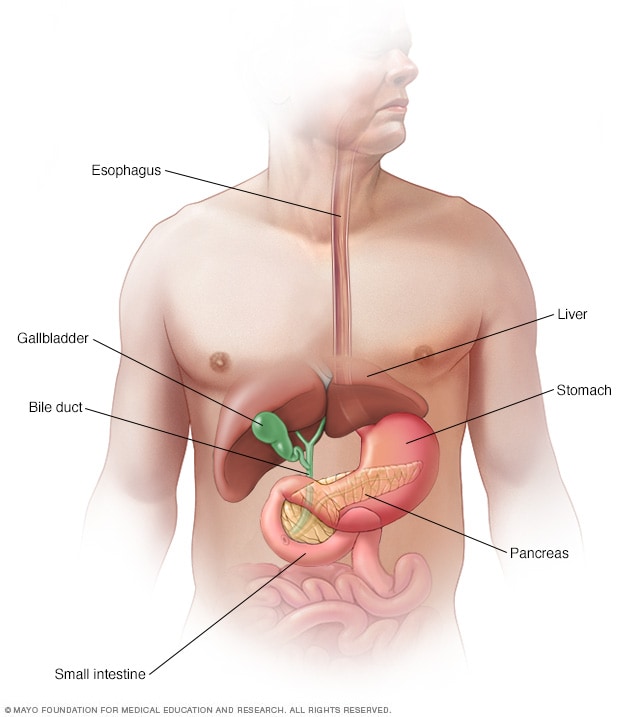Information about the pancreas - where it is and what it does.
Where is the pancreas?
The pancreas sits behind the stomach and above the small intestine. The head of the pancreas sits next to the deodenum on the right side of the human body and the tail of the pancreas lies close to the spleen. (The deodenum is a part of the digestive system that sits between the stomach and the small intestine.) It lies beneath the liver and the gall bladder.
What does the pancreas do?
The pancreas serves two functions in the human body - aid in digestion (referred to as exocrine function) and maintain blood sugar levels (endocrine function).
The pancreas aids in digestion by producing the pancreatic juice. The juice is collected in the pancreatic duct which spans the length of the pancreas. The duct. joined by the common bile duct from the gall bladder, empties into the deodenum. The juice contains chemicals which neutralize the stomach acids, preventing them from damaging the small intestine.
During embryonic development, two distinct buds develop (the dorsal and ventral pancreatic buds), which usually fuse into a single pancreas. In a small percentage of cases, the two buds don't fuse or fuse partially.
Coming to the endocrine function, the pancreas secrets hormones which aid in maintaining blood sugar levels. The pancreas secretes insulin to reduce blood sugar levels and glucagon to increase blood sugar levels.
[Personal question] Why did the human body evolve to have a single organ which performs both roles? Note that some vertebrates contain multiple pancreas or contain no discrete pancreas at all.
Reference - https://en.wikipedia.org/wiki/Pancreas
The pancreas sits behind the stomach and above the small intestine. The head of the pancreas sits next to the deodenum on the right side of the human body and the tail of the pancreas lies close to the spleen. (The deodenum is a part of the digestive system that sits between the stomach and the small intestine.) It lies beneath the liver and the gall bladder.
 |
| Image source - Mayo Clinic |
What does the pancreas do?
The pancreas serves two functions in the human body - aid in digestion (referred to as exocrine function) and maintain blood sugar levels (endocrine function).
The pancreas aids in digestion by producing the pancreatic juice. The juice is collected in the pancreatic duct which spans the length of the pancreas. The duct. joined by the common bile duct from the gall bladder, empties into the deodenum. The juice contains chemicals which neutralize the stomach acids, preventing them from damaging the small intestine.
During embryonic development, two distinct buds develop (the dorsal and ventral pancreatic buds), which usually fuse into a single pancreas. In a small percentage of cases, the two buds don't fuse or fuse partially.
Coming to the endocrine function, the pancreas secrets hormones which aid in maintaining blood sugar levels. The pancreas secretes insulin to reduce blood sugar levels and glucagon to increase blood sugar levels.
[Personal question] Why did the human body evolve to have a single organ which performs both roles? Note that some vertebrates contain multiple pancreas or contain no discrete pancreas at all.
Reference - https://en.wikipedia.org/wiki/Pancreas